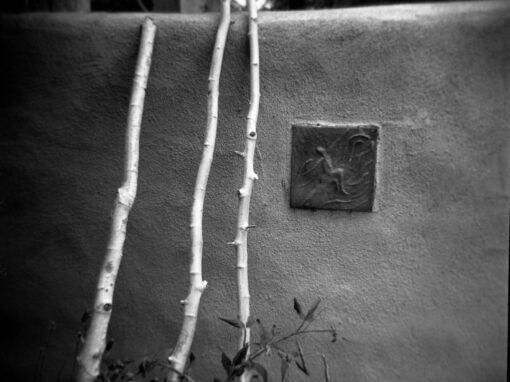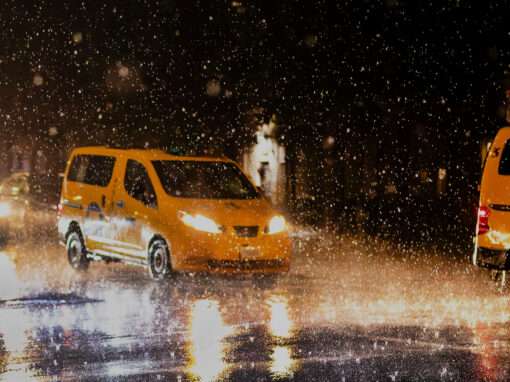I know what’s going to happen.
This book is going to sit on your coffee table. There will be a moment when someone else – a friend, a lover, a stranger who for whatever reason finds themselves sitting on your couch for that moment – will see the book and reach for it. The image on the cover is that compelling.
“Henri Cartier-Bresson: Photographer”
With a foreword from Yves Bonnefoy
Published by Prestel Publishing, 2020
review by W. Scott Olsen

Black and white, of course, the picture shows a country lane that appears to be coming off a larger road and a treeless field. But there are trees on each side of the lane. The trees are tall and have straight trunks. The canopies of leaves join over the lane, giving the impression of a tunnel, and the outline of the joined tops is heart-shaped. Looking down the lane, the tunnel, you see light at the bend where the path takes a left turn and heads off to the horizon.
Everything about this image is invitation and mystery. It’s also famous. Henri Cartier-Bresson. “Brie, France, 1968.”
Your friend, lover, stranger will open to a random page and pause, reading a new image. Then turn, slowly, to another. Every image will ask them to pause.
“You’re a photographer,” they will say. Or, perhaps, “You’re a photographer?”
This book is heavy and large. But you’ll notice the person on your couch does not lean back against the cushions; nor does she or he return the book to the table. You notice there is a way to balance this book on knees. You will look to see what image is open at this moment and the two of you will begin talking.
“Yes,” you’ll say. And then you will smile, because there will be a Cartier-Bresson quote in the back of your head. “The camera can be a machine gun, a warm kiss, a sketchbook. Shooting a camera is like saying, Yes, yes, Yes. There is no maybe. All the maybes should go in the trash.”
Henri Cartier-Bresson: Photographer is a wonderful, generous, moving invitation. Anyone who is even marginally serious or interested in photography knows the name and a handful of images. That guy jumping over or into a puddle, “Behind the Gare Saint-Lazare, Paris, France, 1932,” is everywhere. And I am not going to try to articulate here, in these few words, why his work is great. Volumes have already been written. Museums and galleries around the world have celebrated his work. But here we have a great many of his image all together.
The book was first published in 1979. The press information says, “Reproduced in exquisite black and white, the images in this book range from Henri Cartier-Bresson’s earliest work in France, Spain, and Mexico through his postwar travels in Asia, the US, and Russia, and even include landscapes from the 1970s, when he retired his camera to pursue drawing. While his instinct for capturing what he called the decisive moment was unparalleled, as a photojournalist Cartier-Bresson was uniquely concerned with the human impact of historic events.”
Yet, the book went out of print. It’s been unavailable for some time now. But now it’s back. The 2020 version has a new cover and new separations. And while we don’t talk about book arts very often in reviews, perhaps we should. The design of this book – everything from the color of the paper to the placement of the images to the dust jacket – is elegant.
It makes no difference what type of photography you practice or appreciate. This work is profound. When I first opened the book, I was surprised by how many images I already knew and how many I saw for the first time. Cartier-Bresson’s work ranges farther than most people know and that is one of the graces of a large collection – the joy of new emotion and new thought at the moment of new meeting. And I will say I did not sit with good posture on the edge of a couch. This book and I wound spending hours in a very deep chair.
The book begins with a wonderful introduction by the late French poet and art-historian, Yves Bonnefoy. Happily, he does not write a mini biography. He spends his pages considering, thinking about, musing about Cartier-Bresson’s work. For example, he writes:
“I would like to say straightaway that if Cartier-Bresson does “compose”, it is only in the second, the split second between being surprised by a sight and clicking his camera, when his intuition sparks into momentary action, over almost before it begins, and there is not the slightest revisiting of the situation or object to approach it in a more considered or calculated way. “Composition” in his case entails the sudden perception of something and the equally rapid capture of it, a process of synthesis, in other words, which precedes all analysis and ultimately reveals its futility.”
Later on, he writes:
“…this perhaps gives us a way of looking at him which incorporates both his instinctive receptivity, the immediate and wholehearted ability he has to say “yes”, and his love of forms. What surely happens I that instant of surprise which prompts him to “snap” – as we so aptly say – a scene with his camera, is that a particular place, event and light suddenly slot together to reveal an underlying unity, an organic whole in everything that exists – one which he senses with his entire body and mind – and all he has to do is fix the fleeting image by pressing the shutter.”

Of course, this is also a definition of the decisive moment.
The book ends, not counting some biographic and bibliographic information, with a note, in Cartier-Bresson’s handwriting—his well-known L’imaginaire d’Après Nature.
“–For me, the camera is a sketch-book, an instrument of intuition and spontaneity, the master of the instant which in visual terms, questions and decides simultaneously. In order to give a meaning to the world, one must feel involved in what one singles out through the viewfinder. This attitude requires concentration, sensitivity, a discipline of mind and a sense of geometry.
–It is through economy of means and above all by forgetting one-self that one arrives at simplicity of expression.
–To photograph is to hold one’s breath, when all faculties converge to capture fleeting reality. It is at that precise moment that mastering an image become a great physical and intellectual joy.
–For me photography is to place head heart and eye along the same line of sight. It is a way of life.”
Henri Cartier-Bresson: Photographer is a necessary book. Every page sparks wonder.
A note from FRAMES: if you have a forthcoming or recently published book of photography, please let us know.




